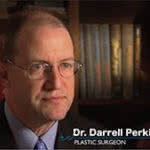Repairing Scarring with Scar Management in Sydney
Scarring after a procedure can be quite difficult to manage and can leave lasting results that are often unflattering. When dealing with scarring, it is vital that one knows how to manage the scarring with proper healing practices and knowledge about how the scarring process works. With such knowledge, one can manage their healing and ensure that their body appears flawless after such a procedure. Dr. Darrell Perkins offers his patients scar management therapy in Sydney.
How does scarring happen?
 Scarring occurs when the body is damaged through some method, be it surgery or traumatic injury. The body makes every attempt to heal and recover from the damage quickly. When the skin is broken, blood and platelets rush into the open wound to prevent the spread of infection. As the white blood cells and platelets enter the area, it may appear inflamed and feel sore due to the cells rebuilding. After a few days, the tissue with begin to heal and appear less pronounced. As the skin heals, some of the skin is unable to heal completely and may form hardened skin known as hypertrophic scars. Over time this hardened skin will begin to fade and feel softer.
Scarring occurs when the body is damaged through some method, be it surgery or traumatic injury. The body makes every attempt to heal and recover from the damage quickly. When the skin is broken, blood and platelets rush into the open wound to prevent the spread of infection. As the white blood cells and platelets enter the area, it may appear inflamed and feel sore due to the cells rebuilding. After a few days, the tissue with begin to heal and appear less pronounced. As the skin heals, some of the skin is unable to heal completely and may form hardened skin known as hypertrophic scars. Over time this hardened skin will begin to fade and feel softer.
In the case of scars that persist and feel hardened or raised, the body had produced too much collagen, leading to too much skin cell buildup. With this excess buildup, the scar is difficult to remove with lotion alone. This may require further intervention. Dr. Perkins offers scar management treatments for patients who suffer from excessive scarring or scars in unwanted places.
How do I manage the appearance of my scarring?
Dr. Perkins recommends several ways to prevent severe scarring and minimizing current scar appearance. The first way he provides is to reduce the amount of time spent in the sunlight. UV rays can make the scar appear darker as the new skin may become hyper pigmented. It also can slow the process of healing.
For lighter scars, he may provide scar lightening cream. This can help darkened scars lighten in appearance. Another method is to apply pressure frequently to the scar. By applying pressure, the scar tissue is less likely to become raised and prominent. Dr. Perkins can provide tape and other methods that are effective in applying constant pressure to the healing area.
Laser treatment is a more invasive procedure that Dr. Richard performs. Laser treatment is recommended when the scar tissue is more prominent or in an area that is visible to the public. Dr. Perkins will use a laser to stimulate collagen growth in the scar tissue.
Surgical treatment is often used as a last resort if the other treatment options have not worked or if the scarring is severe enough that laser treatments fail. In this case, Dr. Perkins may remove tissues or graft new tissue over the scar tissue to hide the scars and promote faster healing.
How do I know what treatment is right for me?
 Depending on your individual case, Dr. Perkins will examine your skin and make a determination on which treatment may be the best course. He will schedule an initial examination in which he will look at your scars and see how severe they are. He will note the areas where they are and how deep they appear. Once he has examined the area, he will offer the least invasive treatment and provide you with advice on scar management in Sydney. If those fail, he may move to more intensive therapies such as laser treatment or surgical intervention.
Depending on your individual case, Dr. Perkins will examine your skin and make a determination on which treatment may be the best course. He will schedule an initial examination in which he will look at your scars and see how severe they are. He will note the areas where they are and how deep they appear. Once he has examined the area, he will offer the least invasive treatment and provide you with advice on scar management in Sydney. If those fail, he may move to more intensive therapies such as laser treatment or surgical intervention.
If you are tired of dealing with scars that fail to disappear or detract from your beauty, Dr. Perkins can help. You can call his office at 02 9587 0871 or contact his friendly staff online to learn more about removing difficult scars.





